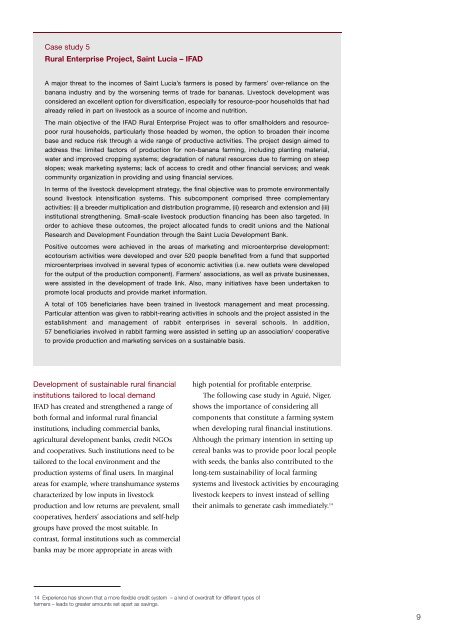Livestock and rural finance - IFAD
Livestock and rural finance - IFAD
Livestock and rural finance - IFAD
Create successful ePaper yourself
Turn your PDF publications into a flip-book with our unique Google optimized e-Paper software.
Case study 5<br />
Rural Enterprise Project, Saint Lucia – <strong>IFAD</strong><br />
A major threat to the incomes of Saint Lucia’s farmers is posed by farmers’ over-reliance on the<br />
banana industry <strong>and</strong> by the worsening terms of trade for bananas. <strong>Livestock</strong> development was<br />
considered an excellent option for diversification, especially for resource-poor households that had<br />
already relied in part on livestock as a source of income <strong>and</strong> nutrition.<br />
The main objective of the <strong>IFAD</strong> Rural Enterprise Project was to offer smallholders <strong>and</strong> resourcepoor<br />
<strong>rural</strong> households, particularly those headed by women, the option to broaden their income<br />
base <strong>and</strong> reduce risk through a wide range of productive activities. The project design aimed to<br />
address the: limited factors of production for non-banana farming, including planting material,<br />
water <strong>and</strong> improved cropping systems; degradation of natural resources due to farming on steep<br />
slopes; weak marketing systems; lack of access to credit <strong>and</strong> other financial services; <strong>and</strong> weak<br />
community organization in providing <strong>and</strong> using financial services.<br />
In terms of the livestock development strategy, the final objective was to promote environmentally<br />
sound livestock intensification systems. This subcomponent comprised three complementary<br />
activities: (i) a breeder multiplication <strong>and</strong> distribution programme, (ii) research <strong>and</strong> extension <strong>and</strong> (iii)<br />
institutional strengthening. Small-scale livestock production financing has been also targeted. In<br />
order to achieve these outcomes, the project allocated funds to credit unions <strong>and</strong> the National<br />
Research <strong>and</strong> Development Foundation through the Saint Lucia Development Bank.<br />
Positive outcomes were achieved in the areas of marketing <strong>and</strong> microenterprise development:<br />
ecotourism activities were developed <strong>and</strong> over 520 people benefited from a fund that supported<br />
microenterprises involved in several types of economic activities (i.e. new outlets were developed<br />
for the output of the production component). Farmers’ associations, as well as private businesses,<br />
were assisted in the development of trade link. Also, many initiatives have been undertaken to<br />
promote local products <strong>and</strong> provide market information.<br />
A total of 105 beneficiaries have been trained in livestock management <strong>and</strong> meat processing.<br />
Particular attention was given to rabbit-rearing activities in schools <strong>and</strong> the project assisted in the<br />
establishment <strong>and</strong> management of rabbit enterprises in several schools. In addition,<br />
57 beneficiaries involved in rabbit farming were assisted in setting up an association/ cooperative<br />
to provide production <strong>and</strong> marketing services on a sustainable basis.<br />
Development of sustainable <strong>rural</strong> financial<br />
institutions tailored to local dem<strong>and</strong><br />
<strong>IFAD</strong> has created <strong>and</strong> strengthened a range of<br />
both formal <strong>and</strong> informal <strong>rural</strong> financial<br />
institutions, including commercial banks,<br />
agricultural development banks, credit NGOs<br />
<strong>and</strong> cooperatives. Such institutions need to be<br />
tailored to the local environment <strong>and</strong> the<br />
production systems of final users. In marginal<br />
areas for example, where transhumance systems<br />
characterized by low inputs in livestock<br />
production <strong>and</strong> low returns are prevalent, small<br />
cooperatives, herders’ associations <strong>and</strong> self-help<br />
groups have proved the most suitable. In<br />
contrast, formal institutions such as commercial<br />
banks may be more appropriate in areas with<br />
high potential for profitable enterprise.<br />
The following case study in Aguié, Niger,<br />
shows the importance of considering all<br />
components that constitute a farming system<br />
when developing <strong>rural</strong> financial institutions.<br />
Although the primary intention in setting up<br />
cereal banks was to provide poor local people<br />
with seeds, the banks also contributed to the<br />
long-tem sustainability of local farming<br />
systems <strong>and</strong> livestock activities by encouraging<br />
livestock keepers to invest instead of selling<br />
their animals to generate cash immediately. 14<br />
14 Experience has shown that a more flexible credit system – a kind of overdraft for different types of<br />
farmers – leads to greater amounts set apart as savings.<br />
9
















